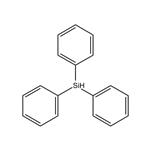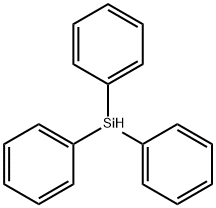Triphenylsilane: Tridentate Lewis-Acid Precursor and Porphyrin-Fusion Application
Triphenylsilane acts as a reactant or reagent for catalytic hydrogen deuterium exchange reactions of silanes, to be oxidized by carbon nanotube-gold nanohybrids, for hydrolysis by ruthenium complexes, for hydrosilylation to produce enolsilanes, for synthesis of bromosilanes, for ozone oxidation of silyl-alkenes for synthesis of α-O-silylated acyloin derivatives.

Tridentate Lewis-acids based on triphenylsilane
In context with our poly-Lewis-acid activities we became interested in using threefold ortho-substituted triphenylsilanes as backbones for Lewis-acid hosts. This group of silanes is well known and several interesting investigations have been reported. Nakazawa et al. have synthesized complexes with silver, copper and gold ions by using triphenylsilanes bearing organophosphane groups in ortho-position. Based on a similar system, Bourissou and Amgoune have generated a cationic trigonal pyramidal gold complex with Lewis-basic properties of gold; it forms Au⋯Si interactions. Another exciting system has been presented by Pascal, using tris(2-mercaptophenyl)silane in a condensation reaction to synthesize an in,in-bis(hydrosilane). This compound was claimed to hold the “world record” for the shortest non-bonded hydrogen–hydrogen contact of any crystallographically characterized compound. All of these compounds contain donor-atoms, but for poly-Lewis-acids donor-free backbones would be highly desirable. However, the synthesis of donor-free triphenylsilanes is generally more difficult, but promises to provide good access to functionalization. The first triphenylsilane meeting these requirements was presented by Takahashi et al. in 1993. They employed a three-step synthesis to yield a triply ortho-iodo-substituted triphenylsilane and used it as precursor to generate 9,10-disilatriptycenes. In this contribution, we report the synthesis of several novel tridentate Lewis-acids and metallic acceptor systems based on ortho-substituted triphenylsilane derivatives.[1]
Based on the motif of triple ortho-substituted triphenylsilanes, several new compounds, containing sites of Lewis-acidic metal or silicon atoms, were synthesized. An improved protocol for the synthesis of donor-atom free tris(ortho-lithiophenyl)silanes (XSi(o-Li-C6H4)3), was developed. They were used to prepare a the bisma-silatriptycene FSi(o-C6H4)3Bi and a triply ortho-silyl-functionalized triphenylsilane FSi(o-Me2HSi-C6H4)3 which was subsequently fluorinated, chlorinated, brominated and pentafluorophenylated. The motif of the ortho-substituted triphenylsilanes was expanded by introducing alkyne and alkene groups between silyl-functions and ortho-positions: FSi(o-R-CC–C6H4)3 (with R = Me3Si, Me3Sn, Me2Al, Me2Ga, Ph3PAu) prepared via metalation of tris(ethynylphenyl)silane and FSi(o-R–H2C–CH2–C6H4)3 (with R = MeCl2Si, MeF2Si, 9-BBN) prepared via hydrosilylation/boration of tris(styrenylphenyl)silane. The host–guest chemistry of the tris(aluminium) receptor system FSi[o-(Me2Al)–CC–C6H4]3 was studied exemplarily by investigating the adduct formation between this tridentate host and a tridentate N-Lewis-basic guest molecule. NMR data, including diffusion experiments for molecular size determination, suggest the formation of an adduct comprising a 2 : 2 ratio of host and guest molecules. These different reaction pathways allowed us to generate tridentate Lewis-acids with different cavities as potential hosts for a wide range of guest molecules. Their host–guest chemistry will be studied in an ongoing project.
Triphenylsilane-fused Porphyrins
Heteroatom-containing π-conjugate systems have been an exciting subject in the last decades because electronic tuning by main group elements enables π-electron systems to acquire intriguing photophysical and electronic properties. This strategy has been extensively employed to tune the properties of porphyrins. Along this line, peripheral silylation of arenes often gives rise to modifications of the optical and electronic properties of the parent arenes such as enhanced fluorescence quantum yields. In this paper, we report the synthesis of triphenylsilane-fused porphyrins by a synthetic protocol consisting of installation of a 2-(diphenylsilyl)phenyl group by Negishi coupling and subsequent intramolecular sila-Friedel–Crafts reaction initiated by a trityl cation and a sterically hindered pyridine. Initially, direct silylation of NiII 5,10,15-tris(3,5-di-tert-butylphenyl)porphyrin 0 Ni was attempted in order to test the reactivities of NiII porphyrins toward the sila-Friedel–Crafts reaction. This reaction furnished β-triphenylsilylated product 1 Ni in 17 % yield with 59 % recovery of the starting material. Encouraged by this positive result, we then applied this intermolecular sila-Friedel–Crafts reaction to intramolecular cyclization to obtain triphenylsilane-fused porphyrins.[2]
In summary, the triphenylsilane-fused NiII porphyrins (5 Ni, 6 Ni, 7 Ni, and 8 Ni) were synthesized by Negishi coupling and subsequent intramolecular sila-Friedel–Crafts reaction. Triply linked NiII porphyrin 13 Ni was synthesized in a stepwise manner. NiII porphyrins 5 Ni, 6 Ni, and 7 Ni were transformed into ZnII porphyrins. These triphenylsilane-fused porphyins display optical and electrochemical properties depending upon their structures. The silicon atom in 13 Ni takes a distorted planarized structure with an almost perpendicular Si-phenyl group, causing an electronic effect due to an effective σ*–π* interaction.
References
[1]Tomaschautzky J, Neumann B, Stammler HG, Mix A, Mitzel NW. Tridentate Lewis-acids based on triphenylsilane. Dalton Trans. 2017 Jan 31;46(5):1645-1659. doi: 10.1039/c6dt04293g. PMID: 28098286.
[2]Kenichi Kato. (2016). Triphenylsilane-fused Porphyrins. Chemistry - An Asian Journal, 11 11, 1738–1746.
You may like
Lastest Price from Triphenylsilane manufacturers

US $0.00/KG2025-03-21
- CAS:
- 789-25-3
- Min. Order:
- 1KG
- Purity:
- 98.00%
- Supply Ability:
- 1000KG /month


